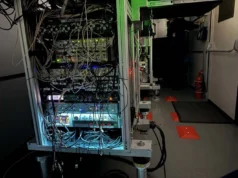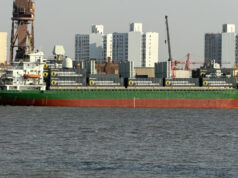BMT has unveiled its Large Uncrewed Surface Vessel (LUSV) concept, with the vessel sitting at over 80m long.
Monty Long, Global Business Development Director for Defence, Maritime and Security at BMT, says:
“The naval landscape is evolving and so must our operating strategies. Whilst the concept of a LUSV is not new, many navies debating their future fleet composition have yet to formally consider the use of these types of high endurance vessels to enhance its surface fleet. Our purpose with this vision was to explore the potential of LUSVs adding mass to an existing or future fleet.
When considered within a mixed fleet approach, the LUSV demonstrates compelling technical feasibility. However, as we chart this course towards the future of naval capabilities, it will be imperative that we further explore the economic viability to ensure a balanced and sustainable naval strategy.”
At over 80m long, to ensure it can operate within high sea states, the LUSV vision comprises six challenges and research areas, say the firm. Those are:
- Command and Control – controlled via shore operations centre but commanded as part of a fully-networked, interoperable fleet.
- Sensor Data Management – providing key, encrypted operational data at the speed of relevance.
- Engineering Systems – considering sustainable propulsion systems and future alternative fuels.
- Vessel and Mission Resilience – allowing the vessel to remain at station whatever is thrown its way, a key factor here is to understand and achieve a balance between resilience on mission and achieving a cost that allows these vessels to support increasing fleet mass.
- Maintenance and Logistics – ensuring system reliability and availability with different approaches to implementing maintenance.
- Modularity – providing a flexible solution with ample capacity for carrying various modular payloads.
The LUSV vision is an evolution of BMT’s Highly Autonomous Warship Technologies (HAWT) programme launched at DSEI two years ago where the company created a vision of a safe and secure lean crewed warship.
Jake Rigby, Research and Development Lead for Defence and Security at BMT, comments:
“Despite the effectiveness of HAWT, they are not the full solution on their own. A future fleet of lean crewed warships enabled with high levels of costly automation systems could lead to a loss of mass/hull numbers for a fixed fleet cost. It needs to be built into a mixed fleet solution as part of the pivot to protean capabilities.
The question for us then became – how can we effectively add mass to the fleet in a cost-effective manner? This led to the creation of the LUSV vision – a simplified supporting vessel that can utilise the full benefits of autonomy to help reduce costs. The LUSV vision strongly complements the HAWT operating concept and could operate alongside the lean crewed vessel providing cost effective, added mass to the fleet and utilising many of the same underlying technologies.”














If you are wondering who BMT are:
BMT announced work on a Lean Manned Future Warship in 2021. This was seen as a necessary step before attempting full autonomy. Not sure where this latest statement leaves that idea, apart from an acronym change.
Interesting stuff. But assuming that they can operate to the needs how fast could these be produced? Can they carry a MK41 system I THINK I PREFER THE PREFER THE CETUS CONCEPT MORE.
Doesn’t have to be either/or, but I think you are right to ask the question about where and how fast would they be produced. I’d guess Rosyth and just one experimental at first. If the Navy bites at all.
Belfast ! . After the support ships are finished . Its more suited to this level of fitting. Frigates and destroyers are a whole level higher again for the trades for fitting out complex combat systems
Test
Testio
Testicles
Scrotum
Ballsack
That was a fun game of word association. Thanks George😂😂😂
Hello?
Hello George?
It’s been a busy news week. George may be suffering from overwork, lack of sleep.
Proud of the team they are rivalling bbc for output
We’re testing issues with the comment system, sorry!
Hello George Mike William. Hello George Mike William. Strength Three. Strength Three Over.
There are issues. I’ve had no notifications now for 3 days!
Comment notifications should be working now.
Seem fine to me now.
Yes, they are. Thank you for looking into it.
George,
Hi, has anyone mentioned an issue w/ edit function recently? No joy recently when attempting to engage edit function. 🤔
Yes. Edit failed to function because a blocker saying we’ve been posting too often kicked in when trying to posting the first edit.
This was/is an issue on Navy Lookout too.
Yes. Edit failed to function because a blocker saying we’ve been posting too often kicked in when trying to posting the first edit.
This was/is an issue on Navy Lookout too.
‘allo, zis is Nighthawk.
😂
🤣😂 Presumably from the BBC series? Especially enjoyed that and Dad’s Army! Anything equivalent broadcast currently?
Honestly I’m just sad nobody picked up on my Guns of Naverone reference.
Sorry, it has been a few years since last viewing that movie; long enough that am unable to recall most scenes. Truly the only scenes recalled are the firing and the destruction of the guns and the reaction of the RN flotilla. 🤔
Likewise. Not seen that film in decades.
Good Moaning.
MK Calling, MK Calling.
Pretty sure he’s been banned.
I wonder if the loyal wingman concept can extend to the naval sphere. A manned ship surrounded by cheaper, expendable unmanned ships.
That ship would need some huge wings to keep up with an aircraft.
It certainly would! But luckily that’s not my idea!
I would think if it can be made to work with aircraft it should work on the water. The air is like 3D and if it stops it crashes. Sea is like 2D and if it stops it doesn’t plummet to the ground.
Main thing I don’t know is how long can a ship run before a human normally has to fix something, change something etc.
A team may be needed on the manned ships to go and fix unmanned boats regularly at sea.
Not sure I fancy them operating off of Iran. Well unless they have some Robot guards without the 3 rules of robotics programming. (Or was it upgraded to 4).
In some ways large unmanned ships are already in operation. Last year the Norwegian chemical company Yara tested a 3,200 ton unmanned vessel with electric propulsion ship named the Yara Birkeland along the Norwegian coast from Horton to Oslo. This vessel is also fitted with automatic mooring arms for unmanned docking and mooring. So the tech is available, been tested and works.
The USN navy have been testing drone ships for a few years in the pacific. The MUSV and HUSV (medium and heavy respectively) were vessels between 1500 and 2500 tons and could carry a reasonably large payload of LRASM/ NSMs and as such could perform the role of surface action groups. The idea was to buddy a group of them up with an Arleigh Burke to increase the destroyers warship sinking abilities. Or have lots of the vessels dotted around in island chain to act as mobile anti ship batteries.
Sounds interesting can see the potential as buddy ships I guess as long as they are immune to jamming. Can’t have them going all Bob Marley on us.
Britain just ordered 50 lol 😆
Fitted for, not with autonomous operation no doubt.
Ok as there was no link I went searching on the BMT website to try to learn more about what it’s envisaged to do. Nothing more than the above so no real idea of what role such a vessel would play. It says controlled from shore but I would have thought it might have had a major role operating in support of a ‘fleet’. Surely they should be clearer as to where they see this going to support their claims. Even a test concept which I am usually supportive of, should have some meat on the bones if the concept is to be ‘sold’ to a potential end user. Test high end aerial drones have had widespread end use scenarios played out for them and still struggled to be brought to service so not having a clear message here doesn’t bode well to attract interest.
Hi all… Just one simple question… why? Why does the Navy need an autonomous vessel, 260 feet long? That’s a massive length for an unmanned vessel.
The MOD will foot the bill, and BMT or whoever will use it to experiment with?
I wonder who sits on the board or advises BMT from ‘government circles’?
Is it equipped for self-defence ?